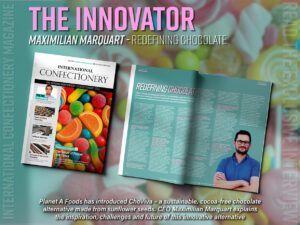The confectionery industry must find innovative alternatives that preserve taste and texture while meeting modern health and sustainability goals, explains Editor Joseph Clarke
For centuries, sugar has been a cornerstone of the confectionery industry, shaping the flavours and textures of our favourite sweets. Its story begins in ancient India, where sugarcane juice was first crystallised around 500 BCE, enabling this once-luxury ingredient to spread across the world. As sugar made its way to Europe via the Middle East, it quickly became a prized commodity, largely due to its high cost and limited availability. By the Middle Ages, sugar was a status symbol, used in elaborate feasts and celebrations, often reserved for royalty and the wealthy. It was used not only in sweets but also to preserve fruits and flavour a variety of dishes.
By the 18th century, the world of sugar was transformed. Sugar plantations in the Caribbean and the industrialisation of the refining process led to a significant drop in its price, making it more accessible to the general population. The rise of British colonial power, combined with the transatlantic slave trade, enabled sugar to become a major export commodity. This expansion laid the foundation for sugar’s growing role in the daily diet of Europe, especially in confectionery.
Victorian England saw the birth of iconic confections like toffee, fudge and boiled sweets, all reliant on sugar for their distinctive taste, texture and preservative qualities. Sugar became the cornerstone of the confectionery industry, providing not only sweetness but also acting as a bulking agent, preservative and flavour enhancer. Sugar not only delighted the taste buds but also allowed confections to be stored for long periods, revolutionising the way sweets were manufactured and consumed.
By the 20th century, sugar was ubiquitous in confectionery production, cementing its place as an essential component in everything from hard candies to luxurious chocolates. Its ability to create different textures—from the crystal-clear structure of rock candy to the gooey softness of caramels—meant that sugar was not just a sweetener but an essential building block of the confectionery experience. However, by the late 20th century, as health concerns began to mount, the sugar industry faced new challenges. Excessive sugar consumption was linked to a host of health problems, such as obesity, diabetes and dental issues. As consumer awareness grew, so too did the demand for healthier alternatives.
Functional Roles of Sugar
To understand why sugar is so integral to confectionery, it’s essential to appreciate its multiple roles. Its sweetness is, of course, the most obvious function, providing the indulgent experience that consumers seek when enjoying sweets. However, sugar does much more than add sweetness. Its chemical properties also impact texture, structure and shelf life.
In crystalline candies like fudge or rock candy, sugar’s crystallisation creates firm, yet melt-in-your-mouth textures. The size of sugar crystals determines the texture—smaller crystals yield smoother confections, while larger crystals give a grittier feel. Meanwhile, in non-crystalline products like caramel or marshmallows, sugar prevents crystallisation, which results in the chewy, soft textures we love. This balance between crystallisation and non-crystallisation makes sugar a versatile ingredient that allows for a wide range of confectionery textures.
Read more latest industry news and developments in our free to download magazine.
Never miss a story… Follow us on:
International Confectionery
@InConfectionery
@InConfectionery
Media contact
Hannah Larvin
Editor, International Confectionery
Tel: +44 (0) 1622 823 920
Email: [email protected]









